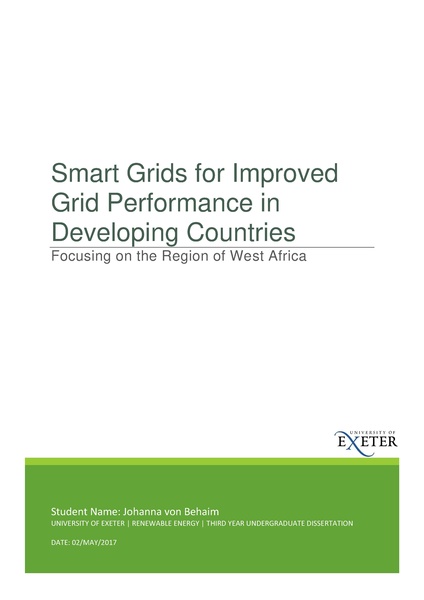File:Smart Grids for Improved Grid Performance in Developing Countries - Focusing on the Region of West Africa.pdf
 Size of this JPG preview of this PDF file: 424 × 600 pixels. Other resolution: 170 × 240 pixels. |
Original file (2,480 × 3,508 pixels, file size: 0 bytes, MIME type: application/pdf, 41 pages)
Summary
| Description |
English: This report investigates the potential for smart grid technologies to achieve improved grid performance in the region of West Africa. Grid performance is assessed based on the electricity networks losses, power outages and capacity for integrating new renewable energy generation, as well as the grid’s ability to cover the electricity demands of the population. The results presented are based on an extensive literature review of smart grid technologies in developing countries, as well as a few expert interviews which were conducted to gain further insight into the opinions of some of the stakeholders currently involved in the sector.
The literature review on the general potential for smart grids in developing countries indicates that there are many opportunities for smart grid technologies to address some of the main problems experienced in electrical networks across many developing countries. However, the review also highlights the importance of detailed planning before implementing smart grid projects in developing countries, to ensure that limited financial resources are allocated effectively. Smart grid technologies need to be tailored to the specific needs of each individual country. The evaluation of the potential for smart grids in the region of West Africa shows that there are numerous possible application points for smart grid technologies through the grid, including the transmission and distribution network as well as the consumer side of the grid. Furthermore, smart grid technologies can be integrated into mini-grid systems. The main potential improvement as a result of the implementation of smart grid technologies include a reduction in technical and non-technical losses (power theft and fraud) throughout the network, improved system stability, facilitated integration of renewable energy generation and more sophisticated revenue collection systems. The latter especially applies to mini-grids. These improvements could potentially lead to more secure and wide spread energy access. |
|---|---|
| Source |
Own Work |
| Date |
2017-06-27 |
| Author | |
| Permission |
See license tag below. |
Licensing
|
File history
Click on a date/time to view the file as it appeared at that time.
| Date/Time | Thumbnail | Dimensions | User | Comment | |
|---|---|---|---|---|---|
| current | 19:01, 27 June 2017 |  | 2,480 × 3,508, 41 pages (0 bytes) | ***** (***** | *****) | User created page with UploadWizard |
You cannot overwrite this file.
File usage
There are no pages that use this file.




















